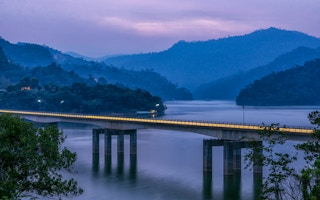Forest survival in the world’s great conservation targets − the Amazon, the Congo and Southeast Asia, for example − is at risk from not just ranchers, loggers and illegal foresters: it’s also under assault from some of the planet’s biggest spenders: governments and the big banks, giant mining corporations and road builders.
A new report warns that in the Amazon region alone − across Bolivia, Brazil, Colombia, Peru and Ecuador − governments have promised $27bn worth of investment on 12,000 kms (7,456 miles) of roads over the next five years. If all the promised infrastructure goes ahead, that could mean the loss of 24,000 square kilometres of forest in the next 20 years.
The Indonesian government is planning to drive a 4,000 km network of highway through a national park in Papua, western New Guinea, for access to 500 sq kms of mining concessions. A new planned railway in Kalimantan, Indonesia, will open up new opportunities for palm oil plantations and coal mining concessions.
And in sub-Saharan Africa nations plan dozens of “international development corridors” to provide access to minerals and to energy. The plans threaten to cut through 400 protected areas and degrade another 1800.
Threat intensified
“Big new projects under way or planned in the Amazon, Indonesia, Meso-America, the Congo basin and beyond, reveal that our insatiable appetite for coal, minerals, metals, energy and agricultural commodities like soy has opened up a new front in the battle to protect the world’s forests,” said Franziska Haupt, executive director of Climate Focus, Berlin, and the lead author of a new report on efforts so far to limit the destruction of the world’s forests.
“Some governments are compounding this threat and rolling back forest protections, as countries struggle to cope with the economic fallout of Covid-19.”
Forests are key to limiting climate change. It is not enough simply to switch from fossil fuels to renewable energy to halt global heating: the climate emergency also requires nations to halt the destruction of, and restore, the world’s great forests.
But much of the promised investment will be devoted to destroying forest and then compounding the damage by producing new reserves of fossil fuels to increase levels of greenhouse gas emissions.
“Many of these projects would never get the green light if the true value of forests was factored in − their role in reducing climate change, protecting animal habitats and reducing the spread of zoonotic diseases [infections caught from other creatures], keeping water sources clean, providing economic opportunity and a long list of other benefits without a price tag,” said Erin Matson, a consultant at Climate Focus, and a co-author.
“Forests are at a dangerous tipping point, and these new large-scale infrastructure projects could push us over the edge and undermine global efforts to stop deforestation.
“There’s a very small − and closing − window of opportunity now to rethink and re-orient these projects in a more sustainable direction. Governments, companies and investors all need to step up, commit to more transparency and act quickly to avoid further harm to people, wildlife and nature.”
The report points out that mining is the world’s “most violent” economic sector, with the largest share of environmental conflicts. In 2019, 50 environmental defenders were murdered.
“Local peoples tend to have little say in economic development approaches and the allocation and use of forest lands,” the report says. “Instead, powerful corporations and national elites influence decision-making to facilitate resource exploitation, while grassroots actors who express their preferences are often shunted aside or ignored.”
Doubtful promise
Forest survival is tough going. Roads, too, are part of the problem: roads and road networks make it easier for farmers and loggers to clear land. They could account for as much as 16 per cent of the destruction of tropical and subtropical forests.
Six years ago, in what became known as the New York Declaration on Forests, endorsed by the world’s governments, multinationals and non-governmental organisations, there were international pledges to halve deforestation by 2020, and end it by 2030.
The 2020 target will not be met. The 2030 pledge looks increasingly improbable. In 2019, a World Bank analysis of 29 case studies of sites of large-scale mining in forests could not find a single example of a mining operation that properly addressed and limited the risks to the forest and its biodiversity.
“This is a salutary reminder that we are living in a dreamworld of pledges, but a reality of very little progress, lack of transparency, vested interests and short-termism,” said Robert Nasi, director general of the International Centre for Forest Research. “Alas, reality will always catch us up.”
This story was published with permission from Climate News Network.

















